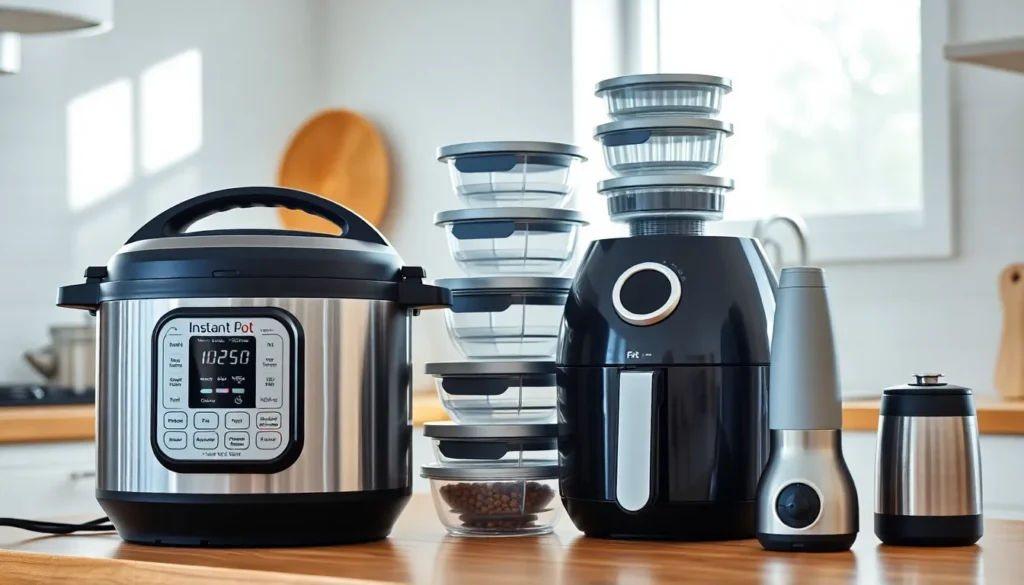A well-organized nursery can be the difference between a serene environment and a chaotic jungle of toys. Imagine walking into a space where everything has its place, and you can actually see the floor. It’s like stepping into a Pinterest board—minus the unrealistic expectations and the hundred-dollar price tags.
Table of Contents
ToggleImportance Of Nursery Organization
Nursery organization plays a crucial role in creating an efficient and calming space for both children and caregivers. An organized nursery streamlines daily routines, making it easier to find essential items like diapers and wipes. Clutter-free spaces promote safety, reducing the risk of accidents caused by tripping over toys or supplies.
Children benefit from a well-structured environment. They learn about responsibility and the value of tidiness when they see their belongings arranged systematically. Easy access to toys and educational materials fosters independence, allowing them to choose activities without adult assistance.
Focusing on efficient storage solutions enhances organization. Utilize shelves, bins, and labels to categorize items, making cleanup simple and straightforward. Designated areas for play, rest, and changing facilitate a seamless flow throughout the day.
Implementing color codes for various items adds a visual element that children understand. Brightly labeled storage encourages them to participate in tidying, reinforcing positive habits. Regularly assessing and rearranging the nursery ensures continued effectiveness of the organizational system, adapting as the child’s needs evolve.
Organization leads to reduced stress for caregivers. Every moment spent searching for needed items detracts from quality time with the child. A well-kept nursery offers a tranquil atmosphere, allowing for focused engagement during play or learning sessions.
Ultimately, prioritizing nursery organization results in a pleasant, nurturing environment for children to thrive. The combination of safety, independence, and ease for caregivers makes a significant difference in daily routines.
Key Principles Of Nursery Organization


A well-organized nursery enhances functionality and comfort. It creates inviting spaces that cater to the needs of both children and caregivers.
Space Utilization
Effective space utilization transforms every square foot into a practical asset. Maximize vertical space with shelves that store books and toys within easy reach. Use multi-functional furniture, like storage ottomans or convertible tables, to reduce clutter. Consider areas for play to give children freedom while maintaining order. Zones for specific activities encourage exploration, such as reading nooks or craft stations.
Material Arrangement
Strategic material arrangement fosters independence and ease of access. Organize toys by type or activity, grouping similar items together for quick retrieval. Label bins and shelves clearly to promote self-cleanup habits among children. Use transparent containers when possible to visually display contents, aiding children in locating their favorites. Arrange frequently used items lower for easy access while keeping less-used materials higher up to minimize hazards.
Types Of Nursery Organization
Nursery organization can take various forms, adapting to different styles and needs. Two prominent methods include traditional organization and modern organization.
Traditional Organization
Traditional organization typically uses classic elements, focusing on established structures and routines. Shelving units are common, allowing for easy storage of books and toys. Bins often come in varied sizes for categorizing items like clothing, art supplies, and sports equipment. Labels play a crucial role, providing clear identification for each container. Children learn to associate specific items with their designated areas, promoting responsibility. Furthermore, the arrangement favors low shelving for frequently used items, ensuring accessibility. This familiar approach fosters a sense of order and comfort for both children and caregivers, making daily routines smoother.
Modern Organization
Modern organization emphasizes minimalism, promoting open spaces and multifunctional storage solutions. The use of modular furniture allows adaptability as children’s needs change. Clear containers with stylish designs provide visual clarity and encourage engagement. It focuses on creating designated zones for specific activities, such as play areas or reading nooks, enhancing functionality. Creative color coding elevates the organizational system, making items visually appealing. Often, a modern approach integrates tech solutions like mobile apps for inventory management. This method not only optimizes space but also encourages creativity and independence in children as they navigate their environment.
Benefits Of Effective Nursery Organization
Effective nursery organization enhances functionality and comfort in the space. Caregivers experience reduced stress due to a well-structured environment. Children thrive in organized settings, learning responsibility and developing independence as they easily access toys and educational materials.
An organized nursery streamlines daily routines, making it easier to find essential items. Having designated areas for play, reading, and creative activities encourages exploration while maintaining clarity. Utilizing vertical space through shelving optimizes the nursery layout.
Storage solutions, such as bins and baskets, categorized by type, facilitate easy cleanup. Color-coding helps children participate in tidying, reinforcing positive habits while promoting safety by minimizing clutter. Regular assessments of the nursery ensure it adapts to the child’s evolving needs.
Strategies like using transparent containers allow kids to see their toys, making it easier to find favorites. Positioning frequently used items within reach fosters independence, while less-used materials can be stored higher, reducing hazards.
Minimizing visual clutter contributes to a serene atmosphere, promoting a calming environment conducive to learning and play. Prioritizing organization leads to increased quality time between caregivers and children, enhancing bonding experiences. The combination of safety, independence, and easy accessibility significantly enriches daily routines, nurturing a thriving space for development.




